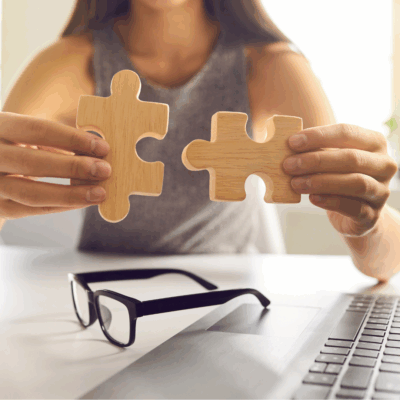Introduction
In today’s digital world, being able to personalize the online experience has become more than just a “nice-to-have”—it’s an essential part of creating an online business to help your customers.
One of the most effective ways to deliver personalized content is by using behavioral triggers.
These are automated actions set off by specific customer behaviors, allowing you to tailor interactions based on real-time data and individual needs.
This blog post will explore how behavioral triggers can enhance the customer experience within an online business, create higher levels of engagement, and increase retention rates.
We’ll walk through the types of behavioral triggers, how to set them up, and ways to use them to make your program feel uniquely personalized for each participant.
Plus, we’ll share examples, stories, and case studies to bring the concept to life.
What Are Behavioral Triggers?
Behavioral triggers are automated responses or actions activated by a customer’s behavior within your online business.
These triggers allow you to respond to customer actions in real time, creating a dynamic and engaging online experience.
Behavioral triggers can help you identify when a customer is engaged, struggling, or ready to take the next step, allowing you to deliver timely support or encouragement.
By using behavioral triggers, you’re able to:
1. Encourage Engagement – Triggers can prompt customers to stay active and motivated within the experience.
2. Address Pain Points – Intervene when a customer shows signs of struggling or becoming disengaged.
3. Provide a Tailored Experience – Offer personalized content, reminders, and feedback based on each customer’s journey.
At TaraLBryan.com, we believe that behavioral triggers can transform an online business from a one-size-fits-all experience into a truly tailored journey.
Let’s explore how to set up these triggers to make every interaction feel customized.
Step 1: Defining Your Behavioral Trigger Goals
The first step in using behavioral triggers effectively is to set clear goals.
Identify what you want to achieve and which customer behaviors are most important to track.
Here are some common goals that behavioral triggers can support:
1. Boosting Engagement
– Keep customers involved and active in your programs with prompts and reminders based on their actions.
2. Increasing Module or Completion Rates
– Encourage customers to complete milestones and steps along your authority framework by reminding them of their progress or suggesting the next step when they reach a certain point.
3. Reducing Drop-Off Rates
– Detect signs of inactivity and re-engage customers with messages that encourage them to return.
4. Encouraging Upgrades or Next Steps
– When a customer completes certain milestones, prompt them with suggestions for the next level or additional resources.
5. Gathering Real-Time Feedback
– Use in-app surveys or follow-up emails to gather feedback after customers complete specific actions.
These goals will guide your choice of triggers and the types of messages or actions you’ll want to automate.
Step 2: Types of Behavioral Triggers that will Personalize the Online Experience
There are several types of behavioral triggers you can set up within your online business.
Each one serves a specific purpose in personalizing the customer journey.
1. Completion Triggers
Overview: Completion triggers activate when a customer finishes a module, lesson, or task. This type of trigger is an excellent way to keep customers engaged by guiding them to the next step.
Example: After a customer completes Step 1 in a business training program, send a congratulatory email with a preview of Step 2.
Include a checklist to help them prepare, keeping the momentum going.
How to Use Completion Triggers:
– Use completion triggers to offer guidance, share additional resources, or celebrate milestones.
– Pair completion triggers with a call-to-action (CTA) that encourages the customer to move forward.
2. Inactivity Triggers
Overview: Inactivity triggers activate when a customer has not engaged with the program for a specified period.
These triggers are ideal for bringing back disengaged customers and reminding them of the value they’re missing out on.
Example: If a customer hasn’t logged into the program in two weeks, send a gentle reminder email, highlighting what they’ll learn in the upcoming actions and offering encouragement to continue.
How to Use Inactivity Triggers:
– Keep the tone positive and supportive, showing empathy rather than pressure.
– Offer resources or suggest an “easy win” action to help the customer re-engage.
3. Time-Based Triggers
Overview: Time-based triggers send messages or notifications based on a set schedule.
This can be useful for weekly check-ins, reminders, or follow-up emails that keep customers on track.
Example: In a six-week fitness program, send weekly motivational emails that preview what’s coming up and offer tips for staying focused.
How to Use Time-Based Triggers:
– Align time-based triggers with the pacing of your program to keep customers engaged and on schedule.
– Incorporate motivational content, such as quotes, success stories, or quick tips, to keep the energy high.
4. Progress Triggers
Overview: Progress triggers activate when a customer reaches a specific milestone or percentage of completion.
These triggers celebrate achievements and encourage customers to keep going.
Example: When a customer reaches the halfway point in a framework or experience, send an email acknowledging their hard work and motivating them to finish strong.
You could also offer a small reward, like access to a bonus.
How to Use Progress Triggers:
– Make each milestone feel special, using positive language to highlight the customer’s success.
– Provide an incentive or bonus to keep customers motivated and excited about progressing.
5. Engagement Triggers
Overview: Engagement triggers are activated by interactions such as completing a quiz, posting in a community forum, or downloading a resource.
These triggers allow you to respond to active engagement in real-time.
Example: When a customer completes a quiz with a high score, send a congratulatory message and recommend advanced resources based on their results.
How to Use Engagement Triggers:
– Use engagement triggers to offer relevant content that enhances the learning experience.
– Provide personalized feedback, showing customers that their engagement is noticed and valued.
Step 3: Setting Up Behavioral Triggers
Once you’ve chosen the types of triggers to use, it’s time to set them up in your online platform.
Many e-learning and marketing automation platforms support behavioral triggers, allowing you to create and customize actions based on customer behavior.
Platforms for Behavioral Triggers
1. ActiveCampaign – Known for its robust automation tools, ActiveCampaign allows you to set up behavioral triggers based on actions, page visits, email interactions, and more.
2. WordPress/Gamipress – One of the most robust core platforms is WordPress. WordPress gives you the flexibility to build a core platform that integrates with a lot of different options to produce and automate behavioral triggers. Gamipress is a way to gamify the triggers and make it into a gamified experience.
3. Even Kajabi has behavioral triggers– Kajabi includes features like progress tracking and automated email sequences, which are perfect for creating completion and inactivity triggers.
Tips for Setup:
– Clearly define the conditions for each trigger (e.g., “If no login activity for 14 days, send an inactivity email”).
– Create templates for each trigger, ensuring consistency in messaging and tone.
– Test each trigger to ensure it activates correctly and provides a smooth experience.
Examples of Behavioral Triggers in Action
Let’s look at real-world examples of how behavioral triggers can personalize the online experience.
Example 1: Inactivity Triggers in an Online Language Learning Program
A language learning platform noticed a drop-off rate after the first two weeks of enrollment.
To address this, they implemented an inactivity trigger that sent a motivational email after seven days of inactivity.
The email included a reminder of their initial goals, a quick quiz to re-engage them, and a link to pick up where they left off.
Result: The platform saw a 20% increase in re-engagement rates, as customers appreciated the gentle nudge and quick re-entry points.
Example 2: Progress Triggers in a Marketing Course
In a six-module digital marketing course, customers received a personalized email when they reached the halfway mark.
The email congratulated them, highlighted what they had accomplished, and previewed the upcoming content. Additionally, it offered a free downloadable “Advanced Strategies Guide” as a reward for reaching the halfway point.
Result: Course completion rates increased by 30%, as customers felt motivated to reach the finish line and earn the next reward.
Example 3: Engagement Triggers in a Fitness Coaching Program
In a fitness program with weekly workouts and nutrition goals, customers who consistently tracked their meals in the app received a monthly message celebrating their commitment and providing a link to advanced meal planning resources.
Result: Customers reported feeling recognized for their efforts, which increased adherence to the program and led to a higher customer satisfaction score.
Step 4: Measuring the Success of Behavioral Triggers
To ensure your behavioral triggers are effective, it’s essential to measure their impact.
Tracking the right metrics can help you fine-tune triggers and understand which interactions create the most engagement.
Key Metrics to Track
1. Re-Engagement Rate – For inactivity triggers, measure the percentage of customers who return to the program after receiving a reminder.
2.Completion Rate – Track whether customers complete more modules or tasks after receiving motivational progress or completion triggers.
3. Engagement Rate – For engagement triggers, measure the frequency of interactions, such as quiz completions, downloads, or community posts.
4. Conversion Rate for Upsells or Upgrades– If you’re using triggers to promote additional resources or premium content, track the conversion rate to assess effectiveness.
Customer Feedback
Gather feedback from customers to personalize the online experience with behavioral triggers.
Use surveys or polls to determine whether they found the reminders helpful, motivating, or even unnecessary.
This qualitative data can provide insights into customer preferences and allow you to optimize your trigger system.
Case Study: Behavioral Triggers Driving Success in a Coaching Program
Case Study:
A business coaching program set up a series of behavioral triggers to keep customers engaged and progressing toward their goals.
They used a combination of inactivity triggers (for customers who missed a weekly call), progress triggers (for customers completing 50% of the program), and engagement triggers (for customers consistently completing action steps).
Results:
After implementing these triggers, the program saw a 40% increase in engagement rates, with customers feeling more connected and motivated.
Feedback indicated that customers felt “accountable” and appreciated the personalized attention.
The program also saw a notable increase in testimonials, as customers who stayed engaged were more likely to achieve results.
Conclusion
Behavioral triggers are a powerful way to create a personalize the online experience in your business.
By responding to customer behaviors in real-time, you can build a deeper connection, foster accountability, and keep customers motivated from start to finish.
Whether it’s through completion reminders, inactivity prompts, or engagement-based feedback, behavioral triggers make your program feel responsive and tailored to each customer’s journey.
Implementing these strategies can significantly improve retention, satisfaction, and ultimately, the success of your business.
Ready to build a more personalized customer journey?
Visit Learn Academy Mentorship for resources, tools, and expert guidance on creating impactful customer experiences.
With behavioral triggers as part of your toolkit, you’ll transform your online business into a supportive, customized experience that customers are excited to be part of.







